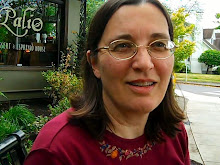He's dressed in black, with a black ponytail, and he smells of cigarettes. He's looking at his cell phone as he boards the bus and finds a seat in the front, side-facing seats. I'm in the front front-facing seat (my favorite, because of the good laptop space).
It's Election Day, and after a word about the failed candidacy of John Edwards, he tells me that he works in biometrics. The retina scan makes for good movies, he says, but there's a danger of long-term eye damage.
On the other hand, there are seven points of the human face that don't change, no matter how fat or how thin or how old we grow, and that can be used for surer identification than a fingerprint.
He said there's a plan out there for identification using a combination of a fingerprint and a card with a 10-digit passwords. You go to the bank and touch a finger to the screen, then put in the password that appears on this key-chain sized card. Bingo. You're in. The passwords are distributed by satellite and new ones are randomly generated every minute. Once you use it, that password is no good anymore. If someone threatens you, stomp on the card. Now your fingerprint is of no use, and you can buy a new password card later for about three bucks.
Fingerprints aren't as good for identification as faces, he says, because the number of data points you use to get a unique match is too many for our current level of computing power. Most law enforcement offices use 18 data points. Some are moving to 33. To be really accurate would take more than 300, but then a speck of dirt between two ridges could throw the whole thing off.
He tells me he created the TransitTracker software that Tri-Met uses to post to the web progress of its buses and trains. The idea came to him one icy evening when he waited an hour and a half downtown for a bus only to find out that the last bus left two hours before. He went home and knocked out a little program over the weekend, worked out the glitches and gave it to Tri-Met. Now he can track the bus's exact location on his cell phone and decide if he wants a brisk or leisurely walk to catch the bus.
His teacher told him when he was a little kid that everything you see could be summarized by mathematics. At the time, he didn't believe it. Now he knows it's true.
Days later, I see him on the bus again. A young man greets him and reports that his software will be distributed in beta version next week. He congratulates him, shakes his hand. He reports that he's invented the fastest hard drive west of the Pecos. They drift into techie jargon, and I drift into my screenplay, but when I look up to collect my stuff, there's a college-age girl with bright, impassioned eyes sitting across the way and listening.
He might be a genius; he might be a lunatic (I can never quite tell on the bus, and it doesn't really matter), but whoever he is, his enthusiasm is infectious, and even my screenplay seems to hold more promise because he's so excited about his projects.
Subscribe to:
Post Comments (Atom)

No comments:
Post a Comment